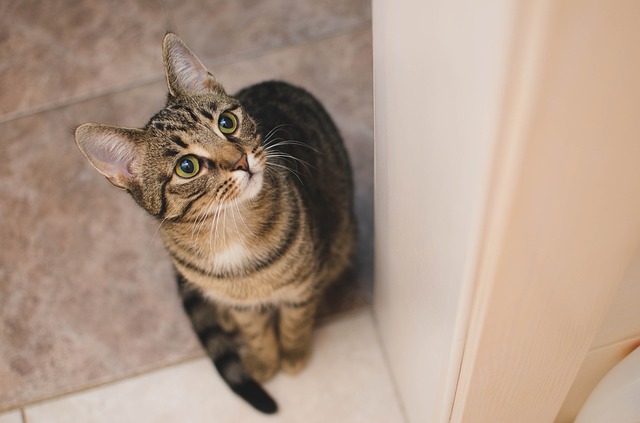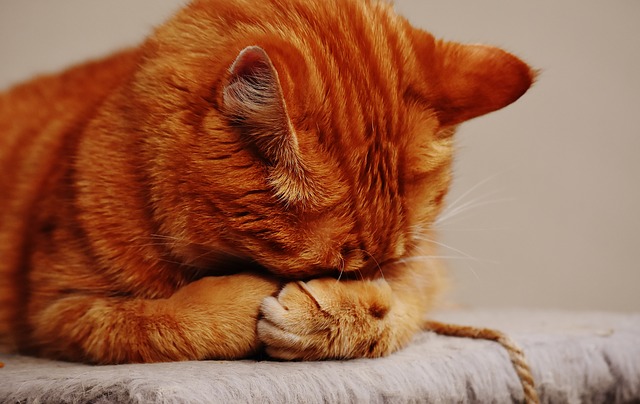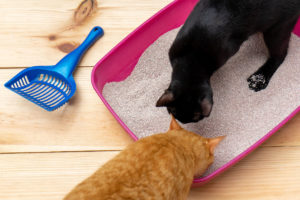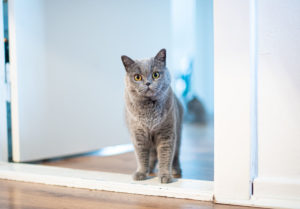Everyone recognizes a few key things when they own a cat. First, you can hear a hairball coming from anywhere in the house. (In fact, that retching sound wakes you from a sound sleep!) Then there’s the unmistakable “burying” motion of a feline registering their dislike of the new canned cat food you purchased. And everyone knows the “wiggle-butt” motion of a pouncing kitten. But nothing upsets a cat owner quite as much as the unmistakable scent of urine – where it DOESN’T belong. A cat peeing outside the box frustrates everyone in the house – including the offending feline! But it may not be the act of rebellion you first think. Learning to puzzle out the cause – and figure out how to correct things – takes patience and time.
Feline Urinary Behavior
From the age of around four weeks, cats start using litter boxes. They learn proper bathroom hygiene from their mothers (or you). To prevent another cat or predator from “finding” them, they bury their urine. This is an instinctual behavior you’ll find in plenty of cat species, even the bigger members of the family. And while a cat peeing outside the box drives owners up the wall, it’s important to differentiate WHAT you’re seeing.
See, cats exhibit TWO behaviors that utilize urine. The first involves crouching down and emptying the bladder. You guessed it – that’s urinating. You’ll see a puddle form. When everything’s working properly (and you don’t have other problems going on), that puddle shows up in the litter box.
The second? This happens when a cat backs up against a VERTICAL surface, lifts their tail, and sprays urine. Rather than peeing, your cat is MARKING. It’s a territorial behavior, and you shouldn’t confuse it with peeing outside the box. They DON’T empty their bladder. True, you get the same unwanted smell, but the amount is dramatically less. And while male cats are the bigger offenders, female cats WILL mark. You can also see the behavior in spayed and neutered felines (though it’ll get worse if you DON’T get the procedures done).
Recognizing what you’re seeing is the first step to unraveling why you have a cat peeing outside the box.
Cat Peeing Outside the Box
Inappropriate eliminations fall into two basic categories: medical issues and behavioral problems. And they look exactly the same 99% of the time. So it’s up to you to take a deep breath, stock up on enzymatic cleaners, and look for extra clues to figure out why your cat is peeing outside the box. All while remaining as calm as possible. Because getting angry and yelling at your furry friend? That will only make the problem worse. Cats DON’T make associations between punishment and action. Instead, they get stressed and upset. And you could end up turning a medical problem INTO a behavioral concern.

Cat Peeing Outside the Box: Health Concerns
People often focus on the frustrations of a cat peeing outside the box, never realizing it’s a cry for help. Urinary problems in cats can lead to a feline avoiding the litter box. If it hurts when they’re IN the box, their logic urges them to try somewhere else. Maybe it sounds ridiculous (particularly when you’re scrubbing the floor) but think about it. Have you ever sprained an ankle? What did you do to avoid the twinge of pain that came from letting that foot touch the ground? It’s the same thought process.
And cats have plenty of urinary health concerns:
- Bladder Stones: Ever had a kidney stone? In humans, doctors want you to get the stone to your bladder so you can pass it. For cats, a stone in the bladder often DOESN’T pass. The pain leads to a cat peeing outside the box. It can also cause obstruction in male cats, a severe emergency.
- Cystitis: Cystitis refers to bladder inflammation, and it can come from ANYTHING (including stress!). The bad part is cystitis can lead to the formation of crystals – which form stones.
- Cancer: Unfortunately, cats can develop cancers within the kidneys or bladder. Sometimes a cat peeing outside the box? It’s the first clue.
- Kidney Disease: Any time you see a cat peeing outside the box, there’s a possibility the kidneys have a problem.
- Metabolic Disease: Diabetes and hyperthyroidism both cause increased urination. And diabetes can cause a cat to FLOOD a litter box. If their usual box is too full, your cat may go somewhere else.
- Urinary Tract Infection (UTI): Cats can end up with UTIs – even if you stay on top of your cleaning duties. And that bacteria causes inflammation. Suddenly, you’re in the cycle of cystitis. And if you have a male cat, a “simple” UTI can lead to obstruction in no time.
Treating Health Concerns
As soon as you see a cat peeing outside the box? You should get an appointment with your vet. You want to rule out a health problem FIRST before you jump to the conclusion that it’s a behavioral issue. Your vet will recommend running lab work to make sure all of your kitty’s organs look healthy. And don’t think young cats are immune! Even youngsters can develop these problems.
If you have a male cat and you’re noticing ANY changes in his urinary behavior? Get to the vet ASAP. Urinary obstruction is a bona fide emergency. When your cat is unable to urinate, potassium builds up in the bloodstream. This is LETHAL. A male cat that can’t urinate can quickly pass away without treatment. It’s much better to be safe than sorry. Your vet can pass a urinary catheter to allow urine to flow again. And then they’re going to recommend a prescription diet to prevent the build-up of crystals in his urine. This is the BEST treatment for your poor little guy.
Some cats end up with chronic urinary issues. This is called feline lower urinary tract disease (FLUTD). Some FLTUD cats DO end up obstructed down the road. As such, your vet may recommend that prescription diet. It’s a good idea (if you have a male cat) to get started as early as possible and prevent an obstruction. Cats who’ve experienced multiple obstructions may need surgical intervention.
Cat Peeing Outside the Box: Behavioral Concerns
Once your cat’s received a clean bill of health, you can turn your attention to the behavioral side of things. A cat peeing outside the box IS trying to communicate something to you. (And, no, it isn’t that they hate you) Once you see the first signs, it’s a good idea to start keeping a log of what’s going on. It’ll help you narrow down what might be causing the problem:
- Where is your cat peeing?
- Are they going on a hard or soft surface?
- How much urine are you seeing?
- How often are the accidents happening? (i.e., Daily, weekly, etc.)
- When do you see things happen? (At night, when you leave for the day?)
You’ll probably see patterns start to emerge. And when you have those notes, you’ll know what’s going on – and how to address the problem.
Change
Do you get bored with the layout of your house? We enjoy changing our homes now and then. But cats? They DON’T like change. A cat peeing outside the box could result when you rearrange their bathroom facilities. Because while they CAN smell the box in its new location, they’re accustomed to the old place. And if you pay attention? Odds are they’re sticking to the familiar.
You’ll need to work through the training process to work them into the new location. Or, better yet, move it a few feet at a time. It’s a little more tedious, but it will prevent those unwanted accidents from happening. And you’ll stop unwanted stress from cropping up in your cat as a result of your redecoration.
The same sudden changes apply to EVERYTHING related to the litter box. You can’t spring a new litter on your cat without warning. They may not like it and choose an alternative location. It’ll smell AND feel different. Instead, mix some in gradually (as you would when making a food change). Cats are creatures of habit. And a cat peeing outside of the box? May simply be telling you to calm down the redecoration habit.

Stress
Cats deal with stress the same as we do. But they don’t express it in the same ways. So a cat peeing outside the box can indicate problems in your kitty’s mind. And unraveling the cause? That may take some additional investigative work. This is where it’s helpful to know WHEN the accidents happen, as they’ll provide you with clues.
Maybe your cat only leaves the box when you go away for the weekend. Cats don’t really like getting left alone. (Even if they seem to act aloof) Your cat can’t tell you they got lonely, so they communicated in the only way they knew how. And it works for the flip side, too – when you have friends over for a party or strangers around working on the house. Your cat’s stress level goes through the roof.
Sometimes, the issue involves the other residents of the house. In multi-cat households, you can end up with dominant personalities. When you’re not looking, one feline can “monopolize” the litter boxes. That leaves the others to scramble for alternative bathroom locations. It isn’t that they WANT to use the bathmat, but it’s the only place they could find. If you clump boxes together in one location, it is even easier for bullies to push someone out. And stress? It’s key in cystitis developing.
Training Fails
The idea is cats come “litter trained.” And, to some degree, that’s true. But, as owners, it’s also possible to throw a wrench into things and interfere with the way cats think. Then we get angry with a cat pees outside the box. And some poor felines end up dumped in a rescue or shelter as a result. But the actual blame? It rests on our shoulders.
Litter box training isn’t the most fun trick in the world. And it’s tempting to rush the process. This is especially true if you’re working with an older cat. Maybe it looked like they had the knack of where you set up the boxes. But now you’re stuck with a cat peeing outside the box. That means you actually DON’T have a feline that’s litter trained. So you need to go back to square one, in a single room. You also need to thoroughly clean all of the areas soiled by accident. And it’s probably a good idea to block them with heavy objects your kitty can’t shift out of the way, so they aren’t tempted again.
The Litter Box
Did you provide a proper litter box? Cats aren’t fans of covered tops. You can test this by introducing an uncovered box and watching what happens. Or maybe they dislike the type of litter you’re providing. And while automatic litter boxes make life easy, they scare some felines away entirely. Your cat didn’t forget their training, but YOU forgot to consider their needs.
You also need to reasonably assess your litter box hygiene. Are you keeping it clean? Cats WON’T use a filthy box – no matter how well you’ve trained them. And some felines are more fastidious than others. So while you can get away with daily cleaning for the majority of cats, others need you to scoop TWICE a day. Try cleaning more often to see if that does the trick.
And if you noted the peeing directly outside of the box, make sure it isn’t because litter piles up around it from exuberant kicking.
Cat Peeing Outside the Box: Correction
No one likes coping with a cat peeing outside the box. But once you’ve pinned down the problem, you can work to correct it. Sometimes it’s easy (clean the box more often). Other times, you need to start your training process over again. And then, you have the times when you may need to consult a behavioral specialist to work on ways to alleviate that stress. As long as YOU remain patient, it’s possible to break the habit and get back to normal.
Most cats do well with a careful retraining process. You’ll want to set them up in a small room (the bathroom’s usually the easiest to clean). It usually only takes a few weeks to get even the most stubborn feline back on the road to proper bathroom hygiene:
- Set up the room with a cat bed, food and water dishes, toys, and the litter box.
- Spend at least FOUR 20-minute sessions a day in the room, playing, grooming, and talking so your cat doesn’t feel abandoned.
- Any time you see your cat pee in the box, offer praise and a reward.
- After TWO WEEKS of consistent box use (and ONLY using the box), allow supervised trips out of the room.
- Once your cat heads for the box on their own for another two weeks, back off the supervision.
“I’m Sorry!”
A cat peeing outside the box ranks as one of the top frustrations of cat owners. But the majority of the time? It isn’t wanton feline behavior. Instead, your cat’s struggling to communicate something to you. Maybe it’s a red flag of a health problem. Or perhaps it’s a desperate need to tell you something’s wrong in their environment. If you’re willing to stop and pay attention, you can easily address the problem.
And in no time? You’ll have the house back to normal and happy. Without any yelling or crying.













No comment yet, add your voice below!